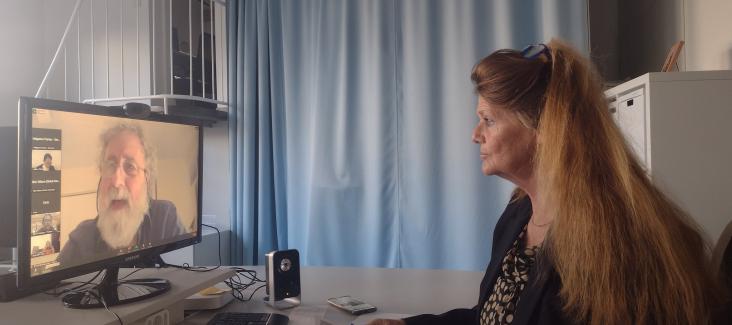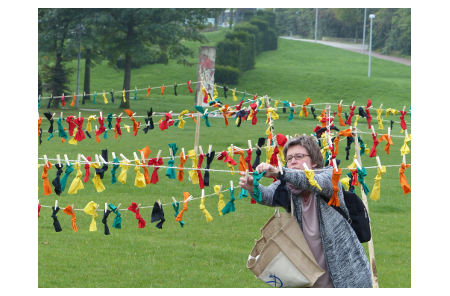The Global Assembly is an ambitious project which aims to give ordinary people a say at COP26. It has two main parts: a Core Assembly and Community Assemblies, which have to face the question: How can humanity address the climate and ecological crisis in a fair and effective way? On the one hand, the Core Assembly consists of 100 people that represent a snapshot of the population of the planet. The Core members were chosen by a lottery (sortition), with the reliance on a NASA database of human population density. From the lottery 100 points around the world were selected from where participants would be recruited. One of these points landed near Cologne and Democracy International (DI) was contacted by the Global Assembly to help them gather pools of potential participants. We went out on the streets to gather probable members and used snowball sampling to gain more contacts and make sure that our sample was diverse. The Core Assembly member from Germany, Helganna Trantes, was chosen through sortition from the pool of potential participants. The sortition method allowed the Global Assembly’s organizers to make the Core Assembly as representative of the demographic profile of the global population as possible; for example, 70% of members earn $10 a day or less. Overall, members proportionally represent the world’s population by gender, age, geography, attitude toward climate change, and educational level.
Prior to COP26, the Core Assembly members learned about the issue of the climate and ecological crisis with the help of experts and learning materials. In addition, they gathered in weekly meetings to discuss the problem and were supported by facilitators and their host organization. As a Community Host, our task was to provide technical support for the German Assembly Member and help her with translation when needed. All participants were provided with a stipend to ensure that they could take part. Members met two or three times a week in small groups in sessions of three hours to deliberate. Once a week all 100 members meet, again in a three-hour session, to exchange what they have discussed in their small groups and to build on their current ideas and recommendations. The final goal of these sessions was that participants draft together a proposal to world leaders on how to address the climate and ecological crisis in a fair and effective way. The identity of members is confidential, but those who were willing to reveal their personal information and faces were entered into a lottery. Again through sortition 10 people from the Global Assembly were chosen to present the group’s recommendations to COP26 on November 1st. Helganna was one of the people who participated in the lottery and was selected to be one of the presenters at COP26. Members’ proposals will also be featured in a final report in March 2022 and they have to receive an official response from the UN’s COP26 process.
Additionally, community assemblies give people all around the world the chance to also get involved into the process. For example, people who have common interests can form their own Community Assembly, learn about the problem in the same manner that Core Assembly members did and get the chance to have a say in global decision-making. Community Assemblies’ recommendations will also be included in the March 2022 final report.
After the chosen members of the Global Assembly introduced the proposals made during their deliberations, Helganna gave her open reflection in front of DI’s team, whose members have supported her during this journey and will continue to do so. She has had an interest in the topic of climate change long before joining the Global Assembly. Helganna has worked in the field of organic agriculture and knows a lot about restoration of forests and how to keep the earth healthy. She has seen the devastating impact of climate change before her eyes and tried to take individual steps to fight against it. For example, since the climate has become too hot, Helganna noticed that trees in the park were suffering. Thus, she started watering them. She has been doing that for three years. It started as something that she was doing alone, because it was necessary. Nevertheless, now it has grown to be a real movement. In the same manner, we all hope that the Global Assembly - something that started out of necessity to bring the voices of people to the international arena can further develop and truly open the international decision-making scene to citizens in the long term.
Regarding the role of citizens’ assemblies as a tool to fight climate change, Helganna commented that it is “advantageous that the citizens are asked to partake more and their opinion is heard. And then if they are heard, that their opinions are dealt with.” She added that “citizens’ assemblies are not only for the climate. Certainly in the future citizens’ assemblies can be used for other topics as well. They are an instrument that allows citizens to be heard. The Global Assembly is a good pilot and let’s see how it can be expanded.” Furthermore, Helganna emphasized that the Global Assembly put forward some essential demands at COP26, from which the most important for her were that we should realize that “we don't live on the planet Mars, we live on Earth. And this Earth feeds us, gives us air and everything else. We shouldn’t treat what sustains us so badly. [...] We can try using the best techniques and putting a lot of energy into it: monetarily, with intelligence, with everything we have. We could try that. We haven't tried that yet. If one says there is not enough money - nonsense, we can make it. For example, with a transaction tax of 0,01 percent. We have money. There is enough money on the planet. That is not the issue, it is what you do with it. And you also have to make the global players responsible.” Helganna is just one of a hundred participants, who all made valuable recommendations and together formed the “People’s Declaration for the Sustainable Future of Planet Earth“ with commonly agreed statements.
The UN is the global arena where issues that affect all people, such as climate change, are discussed and strategies and solutions are being drafted. The Global Assembly is an ambitious project which opens the UN to non-state actors that have the power to make influential contributions towards the formulation of resolutions to the global problem of climate change. In this context, Susan Nakyung Lee, one of the Global Assembly organizers says, “the project grew out of the recognition that there’s one glaring missing piece in global governance at the moment, and that’s a platform that is authentically able to centre and amplify citizens’ voices. So, we envisioned this project to, in the long term, be a permanent infrastructure that acts as a sort of node, bringing civic intelligence to these various other nodes that already exist in global governance – like COP.” We cannot agree more with this statement! Relating to this, Caroline Vernaillen, responsible for Global Community Building at Democracy International, commented that “the Global Assembly is an important pilot project to test how citizens’ perspectives that are not traditionally heard can be brought into global governance. In the past years, we’ve seen several national citizens’ assemblies in different countries around the world. All of them show that ‘ordinary’ citizens are often more willing and able to move forward on politically difficult or deadlocked issues than governments are. The important thing now is to connect these important instruments of consensus-building to instruments of decision-making.” Democracy International’s board member, Erwin Mayer, who works as a consultant on energy issues, has also followed the Global Assembly project closely and made the important input that “one way to make global Citizens’ Assemblies more influential and decisive is to combine it with direct democracy. The sovereign, the people, should not just be limited to a consultative role. They should have the final say in binding referendums. Citizens' Assemblies enable a better deliberative discussion as long as they are concrete and science based enough.”
Furthermore, global leaders have also realized the importance of the Global Assembly. For example, first Minister of Scotland, Nicola Sturgeon, has said in her speech at COP26 that we need a Global Citizen’s Assembly because “often some of the best ideas, some of the best solutions, and some of the most intense pressure comes from citizens and communities [...] when leaders like me listen to you, genuinely listen to people’s voices from across the world, then I believe that will and certainly should lead to fairer outcomes, and outcomes that are respected more by everybody whose lives are impacted by them.” Minister Sturgeon touched upon the vital team of listening. Yes, people received the chance to speak out, but now they also have to be heard. Too often recommendations of citizens’ assemblies are not followed-up on. On the national level, we can take a cue from the Irish process, where several proposals put forth by citizens’ assemblies have been put to a popular vote in a referendum (though interestingly enough not their recommendations on climate change). Clearly, we hope to see that world leaders take the “People’s Declaration for the Sustainable Future of Planet Earth“ that was voted on by the Global Assembly seriously and take these inputs into their negotiations towards more stringent climate goals. If citizens' assemblies are to become a permanent part of our global infrastructure, we would like to see the UN General Assembly and/or Security Council committing to discussing the citizens’ recommendations and issuing a resolution in follow-up.


